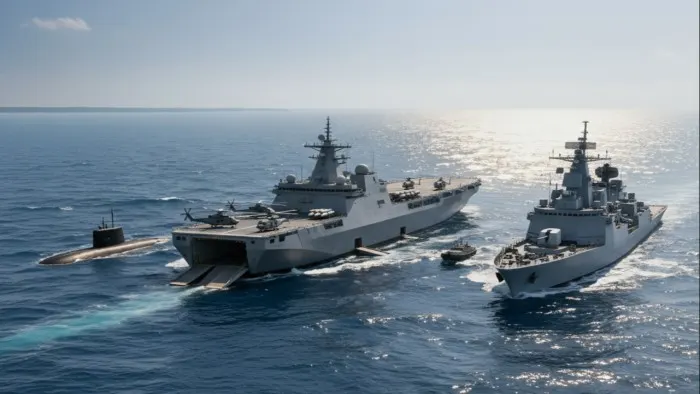On October 23, 2025, the Defence Acquisition Council (DAC) chaired by Defence Minister Rajnath Singh approved the Acceptance of Necessity (AoN) for the construction of four large Landing Platform Docks (LPDs) at an estimated cost of Rs 33,000 crore. This marks one of India’s most ambitious naval projects in decades, designed to enhance amphibious warfare, humanitarian operations, and maritime power projection.
Strategic Importance of the Acquisition
The approval is part of India’s broader Rs 79,000 crore modernisation package for the Army, Navy, and Air Force. For the Navy in particular, the LPDs represent a game-changing capability in the Indian Ocean Region (IOR), where growing Chinese naval presence has reshaped the security landscape.
Unlike traditional surface combatants, LPDs serve as floating military bases, capable of launching combined land-sea-air operations. Their arrival will enable India to:
- Project joint operational power far beyond its coastline.
- Rapidly respond to contingencies in the Indian Ocean Region, Indo-Pacific corridor, and island territories.
- Provide large-scale Humanitarian Assistance and Disaster Relief (HADR) after natural calamities, a growing regional demand given India’s geographical position.
Strategically, this acquisition aligns with the Atmanirbhar Bharat initiative, positioning India not only as a major defence consumer but also as a builder of advanced amphibious warships through domestic shipyards such as Larsen & Toubro, Cochin Shipyard, Mazagon Dock, and Hindustan Shipyard.
Capabilities India Will Gain with the LPDs
Each LPD, weighing between 30,000 and 40,000 tonnes, will combine heavy-lift, combat, and command capabilities in a single platform. These ships will feature:
- Aviation facilities capable of operating helicopters, drones, and potentially VTOL aircraft.
- Floodable well decks for launching Landing Craft Mechanised (LCMs) and hovercrafts carrying tanks and troops to shore.
- Capacity to carry 2,500–3,000 troops and more than 80 armored vehicles, effectively transporting a full battalion-sized force.
- 32 VL-SRSAMs, 16 long-range anti-ship missiles, and Close-In Weapon Systems (CIWS) for layered defence.
- Integrated Command Information Centres, turning each vessel into a command-and-control hub for joint Army-Navy-Air Force coordination.
The new LPDs will effectively transform India’s naval operational flexibility—from traditional coastal roles to full-scale expeditionary and coalition operations.

Global Comparison: Standing Among Naval Powers
Globally, LPDs are at the core of modern blue-water navies:
- United States: The Wasp-class and America-class amphibious assault ships (45,000 tonnes) double as light aircraft carriers, capable of operating F-35B fighters and heavy helicopters.
- China: The Type 075 Yushen-class (up to 40,000 tonnes) forms a key part of Beijing’s power projection in the South China Sea and beyond.
- France: The Mistral-class (21,000 tonnes) is optimized for troop transport, medical aid, and joint international operations.
- India (Future LPDs): With 30,000–40,000 tonnes displacement, integrated missile systems, UAV capability, and indigenous build, India’s future LPDs will bridge the gap between France’s Mistral-class practicality and America’s Wasp-class strength, making them among the most versatile in the Indo-Pacific.
Strategic Impact: From Regional Power to Maritime Leader
The induction of these four LPDs will be a transformational milestone for India’s maritime doctrine. Together with INS Vikrant and the existing INS Jalashwa, they will:
- Expand India’s blue-water footprint from the Persian Gulf to the western Pacific.
- Strengthen deterrence against naval encirclement and regional coercion.
- Reinforce India’s role as a net provider of regional security, enabling both combat-readiness and humanitarian outreach.
Beyond shipbuilding, the project strengthens India’s defence-industrial base, advancing the “Make in India” framework through high-technology transfer, modular design skills, and steel manufacturing for large combat vessels.
In conclusion, the 2025 LPD acquisition signals India’s evolution from a coastal-defence navy to an agile expeditionary force capable of operating across the world’s busiest maritime corridors—setting the stage for a new era of strategic autonomy and regional leadership.